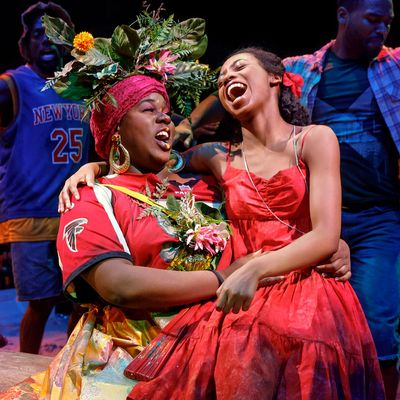
Outside Circle in the Square, the winter winds are starting to snap. But inside a different wind is blowing — literally. In Michael Arden’s vivid, celebratory revival of Lynn Ahrens and Stephen Flaherty’s Once on This Island, the elements have been brought indoors. A blanket of sand covers the long oval floor of Dane Laffrey’s lush, immersive set. A pool of water contained by a sandbag embankment fills one end of the stage. A fire burns in a rusted oil drum. A child plays in the sand. A man fishes in the pool. Someone starts cooking on a makeshift hot-plate stove. A dark-eyed, wild-haired woman with a knife strapped to her thigh leads a live goat on a leash. Later, a thick white fog rolls through the space as the cast light candles, giving the effect of stars piercing through a heavy cloud. And in the staging of a storm, not only do electric pulses of lightning flash in the darkness — gusts blow through the audience’s hair.
The experience of Once on This Island is both gorgeously sensual — you can almost feel the humidity in the theater — and evocative of something all too real, common, and devastating. Arden, Laffrey, and costume designer Clint Ramos have created a hurricane-racked world, a community of survivors, subsisting and rebuilding in the face of repeated ruthless natural disasters. New Orleans, Houston, Florida, Puerto Rico — they’re all present in the tone and texture of this revival, and the acknowledgement feels not only responsible but fitting. After all, Once on This Island is a story about the life-sustaining power of myth and ritual in the face of hardship. Amid the toppled telephone poles and rusting corrugated metal, the clotheslines hung with cheap hand-me-downs, the remnants and the wreckage, a community comes together to tell a story about “the strength of love against the power of death.” As the ensemble sings in the show’s opening number, “We are dancing just to stay alive.”
If only the story itself were a better one. While the score of Once on This Island has some standout numbers, it feels largely generic, and the musical’s supposedly uplifting plot — a Hans Christian Andersen-esque tale of feminine self-sacrifice — leaves me feeling tired and crabby. Arden’s production, though, is striking proof that a play, or a musical, can be more than the sum of its parts. Working with an inspired design team, an excellent choreographer (Camille A. Brown), and an all-around stellar cast, Arden has created a sparkling firework of a show — visually captivating and vocally robust — that consistently transcends its own source material.
That source material by Ahrens (book and lyrics) and Flaherty (music) is based on the novel My Love, My Love by Rosa Guy. The musical’s tragi-romantic story line is also often mentioned in the same breath as Romeo and Juliet, but the comparison is a facile one. Once on This Island has more in common with the “The Little Mermaid” (the tragic one, not the Disney movie) than with Shakespeare’s star-crossed lovers. To begin with, Romeo and Juliet meet and fall in love while both are actually conscious, and when they die, they die together. No such luck for Ti Moune, the passionate young heroine of Once on This Island. The musical is her story, her legend, told by the inhabitants of a French Antilles isle where “two different worlds” exist side by side and in stark contrast: the world of the wealthy “grand hommes, with their pale brown skins and their French ways,” and that of the peasants, “black as night” and “eternally at the mercy of the wind and sea.”
Ti Moune — an orphan raised by a loving peasant couple, Tonton Julian and Mama Euralie — falls in love with the pale, privileged Daniel Beauxhomme when he crashes his fancy car on the wrong side of the island. In the mother of all Florence Nightingale complexes, she throws herself into trying to heal him, offers her life in exchange for his (this while he’s still in a coma), and eventually follows him back to the gentry’s side of the island. There she becomes his nurse (again), then his mistress; then she’s casually discarded when he admits that he’s engaged to a girl from his own world. After that, she’s cast out by the rich folk and wastes away outside their gates as a martyr for love — if “love” can be rightly defined as self-immolating devotion to a callow teenage schmuck who was never planning to do right by you and who sings condescendingly about how sexy it is that you “face the future with no demands” and “see the world through a child’s wide eyes.” Daniel’s “Some Girls” is one of the creepiest supposed love songs I’ve heard in a long time.
It’s not poor Ti Moune’s fault, but my patience for teary tales of girls sacrificing themselves for assholes and inspiring even the gods through the beauty of their innately feminine selflessness was used up a long time ago. It might have happened once on this island, but it’s a narrative that’s still far too common, too enduringly popular, for comfort.
But onto those gods. Ti Moune’s legend is also a story of the “powerful, temperamental” deities who rule over her home, this island beset by the elements and stratified by cruel colorism. In their daily awareness of life’s fragility and unpredictability, the island’s peasants “pray constantly” to the Earth Mother Asaka, the god of water Agwe, the love goddess Erzulie, and the “sly Demon of Death” Papa Ge. In Arden’s version, the gods are members of the storytelling community, just like everyone else onstage. Ti Moune’s is a story they all know, a ritual in which everyone plays a role, and here, they’re telling it for the first time to the youngest member of their tribe, a little girl played by the way-too-adorable Emerson Davis.
With each appearance of the four actors who play Once on This Island’s volatile pantheon, Ramos adds to their costumes, using elements of the scrappy, storm-strewn world to create clothes fit for the gods. Early on, the utterly fabulous Alex Newell — in a gender-fluid turn as Asaka — grabs a flowery plastic tablecloth and wraps it around himself to take on his role as the earth goddess. When we see him next, Ramos has constructed an actual voluminous skirt for him out of the same material. Agwe, the powerful Quentin Earl Darrington, begins as the man who was fishing in the pool. Add a necklace of plastic flotsam and a streak of blue face paint, and there’s the God of Water. And that woman with the live goat on the leash? The black knife on her thigh was a good hint. Merle Dandridge gives a chilling, full-throated turn as Papa Ge, the god of death, and Ramos adds layer upon layer of fantastical, creature-like elements to her original costume of leather straps and dark rags. (Poor goat. Having Papa Ge as its keeper probably has something to do with its implied fate in the show.)
As Erzulie, the goddess of love, Lea Salonga is serene and charming, though she’s got to deliver one of the musical’s soppiest numbers (“The Human Heart”) and model an ensemble that’s less compelling than those of her divine comrades. Unlike with Newell, Darrington, and Dandridge, Ramos all but abandons Salonga’s original look in creating Erzulie’s final form. Her diaphanous white dress and Project Runway-esque headdress seem only tenuously connected to the world of sand and storm debris. And the production is strongest when it stays grounded in that world, aware of its frame and making inventive, vital use of its materials. This is why a number like “Rain” — in which the ensemble of storytellers uses sheets of scrap metal and flashlights to conjure a car speeding down a wet road — is far more mesmerizing than some of the play’s later sequences. Once we’ve entered the world of the grand hommes, real furniture is carted onstage, and girls like Andrea (Daniel’s wealthy betrothed) wear fully realized, sparkling ball gowns. Though Arden’s aesthetic is always lavish — and beguilingly so — it’s at its most exciting when he’s making treasure out of trash, appealing to our imaginations rather than simply to our liking for shiny things.
But Arden’s hand never falters with his ensemble, whose thunderous voices and jubilant energy crash through the theater in waves. Newell blows the roof off the place with Asaka’s brassy, big-hearted showstopper “Mama Will Provide” and as Ti Moune, a willow-wand in a red dress, Broadway newcomer Hailey Kilgore has a voice that pours out of her thin frame like an island wind — sometimes a lilt, sometimes an unstoppable roar. She’s all flashing eyes and youthful anticipation in her first big number (“Waiting for Life”) and later, she touches something deep and glorious in her execution of Brown’s vigorous, foot-stomping choreography for “Ti Moune’s Dance.”
In their final celebration of Ti Moune’s unvanquished love, the ensemble of Once on This Island sings a rousing finale called “Why We Tell the Story.” It’s a mark of this production’s power that, despite my reservations about the story at hand, I felt my spirits lift with the voices of Arden’s remarkable cast. Sometimes, a story’s real splendor is in the act of its telling.


